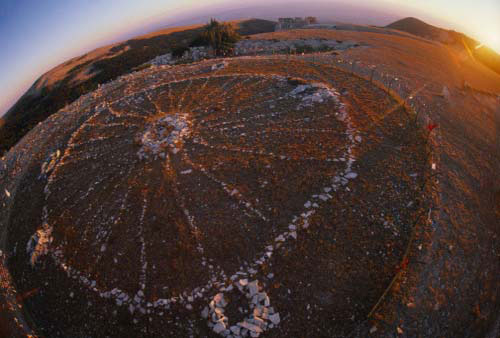Scientists studying these enigmatic configurations in the late nineteenth century called them medicine wheels because of their similarities to the Plains Indian symbols commonly used in ceremonial artworks. For centuries, these Indians have made beautifully quilled circles with a simple cross in the middle. Plains Indian warriors often wore such a power symbol fastened to a war shield, their horse’s mane or bridle, or their own hair. These spiritual ornaments had specific meaning to their owners, who described them to Europeans as medicine. Early settlers thought these resembled great wagon wheels.
Later, research on the Plains Indians identified other features characterized by a variety of stone circles and spoke configurations. Because of general similarities to the Bighorn Wheel, the term “medicine wheel” was extended to describe them, as well.
The first medicine wheel was discovered in 1855.
 The Big Horn Medicine Wheel, near Lovell, Wyoming (pictured above) was discovered in 1855. It consists of a central circle of piled rock surrounded by a circle of stones, with rays of stones traveling out from the central core of rock and its surrounding circle. The whole structure looks rather like the wheel of a bicycle from the air. The Big Horn Medicine Wheel is located on a plateau at an elevation of 9,956 feet. It is 80 feet across (23 metres) with 28 rock spokes. The exact layout of a medicine wheel varies from site to site.
The Big Horn Medicine Wheel, near Lovell, Wyoming (pictured above) was discovered in 1855. It consists of a central circle of piled rock surrounded by a circle of stones, with rays of stones traveling out from the central core of rock and its surrounding circle. The whole structure looks rather like the wheel of a bicycle from the air. The Big Horn Medicine Wheel is located on a plateau at an elevation of 9,956 feet. It is 80 feet across (23 metres) with 28 rock spokes. The exact layout of a medicine wheel varies from site to site.
Medicine wheels date back to 2000-4000 BC, or older
There is no real consensus as to when medicine wheels began to appear in native american cultures except to say that some of the wheels date back to 2000-4000 BC, the same time the Great Egyptian Pyramids were being built in Egypt or the Stonehenge complex in Europe.
Some archaeologists and geologists even go so far as to speculate that The Big Horn Medicine Wheel is as old as a few million years.
The Moose Mountain Medicine Wheel coincides with migration of the Blackfoot Indians
Carbon dating indicates the site of the Moose Mountain Medicine Wheel in southeastern Saskatchewan, Canada has been used at least since around 800 AD. However, older stones may be buried under the exposed stones we can see now. Incidentally, Blackfoot oral history says the Blackfoot people (known as Blackfeet in the US) moved into the region that is now Saskatchewan and Alberta, Canada and Montana, USA around 800 AD.
According to Blackfoot oral history, when the Blackfoot arrived in this new region, it was already populated by two groups of people called the “Tunaxa” and the “Tunaha.” It is believed the three groups assimilated into the people we know as Blackfoot today, and the Blackfoot, along with other Plains Indian tribes, carried on the tradition of building medicine wheel monuments.
Alberta and Saskatchewan provinces in Canada have the majority of known medicine wheels.
Others are located in the US states of North Dakota, South Dakota, Montana and Wyoming. Other, larger astronomical and ceremonial petroforms and Hopewell mound building can also be found in other areas of North America.
Alberta, Canada has about 66% of all known medicine wheels in North America (a total of 46). This suggests that Southern Alberta was a central meeting place for many Plains Indian tribes who practiced medicine wheel ceremonies. A majority of these ceremonies were to celebrate the Summer Solstice – June 21st, while other ceremonies were carried out throughout the summer season.
In all, estimates of pre-20th century medicine wheel sites that are still in existance in North America today vary from 70 to 136 to 170, depending on the source, but many medicine wheels are disappearing due to vandalism and souvenir seekers, and some anthropologists speculate that they will all disappear completely within the next generation of people.